Help support this long-running e-zine,
FILM MUSIC REVIEW
on the
web since 1998
Order your copy of this informative book
which includes discussion of
the 1933 KING KONG score...
.jpg)
A GUIDE TO FILM MUSIC: Songs and Scores
(PineTree Press)
| Editor's Choice - Best of the Month for October 1999 |
.jpg)
KING KONG (1933)
Music score by Max Steiner
20 tracks (Playing Time = 73:35)
Original Motion Picture Soundtrack Composed and Conducted by Max Steiner. Album Produced by Ray Faiola.
Rhino Movie Music CD R275597
Rating: ****
Track Titles:
THE STORY OF KING KONG (dialogue and music)
1. The Adventure Begins
2. Aboard Ship
3. Arrival At Skull Island
4. The Ship At Night
5. A Bride For Kong
6. The Log Sequence
7. Denham's Escape
8. Kong Attacks The Village
9. Kong In New York
10. Kong Escapes
11. Death Of King Kong
KING KONG MUSIC SUITE (previously unreleased)
12. Main Title
13. A Boat In The Fog
14. The Forgotten Island I
15. The Forgotten Island II
16. Jungle Dance
17. The Sailors
18. The Bronte
19. Stolen Love/ Humorous Ape
20. The Aeroplane/ Finale
Well film music fans, it's here at last - the first great film score of the 20th century.And this is the first time that the complete original soundtrack has been released on CD.
So far, there have been two excellent re-recordings of Steiner's KING KONG score:
The first one includes a slightly abridged version of the score, originally recorded in 1976 with the National Philharmonic Orchestra, conducted by Fred Steiner (no relation). It was released on a Label X CD (later available on a Laserlight CD, together with Steiner's THIS IS CINERAMA and DEATH OF A SCOUNDREL).
The other re-recording is the preferred one, featuring the complete soundtrack restored by John Morgan, performed by the Moscow Symphony Orchestra and conducted by William T. Stromberg. It was first available on a Marco Polo CD and later on a Naxos CD.
This recording was named by
FILM MUSIC REVIEW as one of the
Best Vintage Soundtrack Releeases of 1998.
There will be some diehard film score fans who won't like the first part of the Rhino CD, titled:"The Story of King Kong." It includes about 49 minutes of dialogue and music taken directly from the film's soundtrack.
But if you're a huge fan of this classic movie, like I am, then you'll enjoy every minute of the snappy dialogue, including the wonderful screams of the delicately beautiful Fay Wray, shown here in a scene from KING KONG...
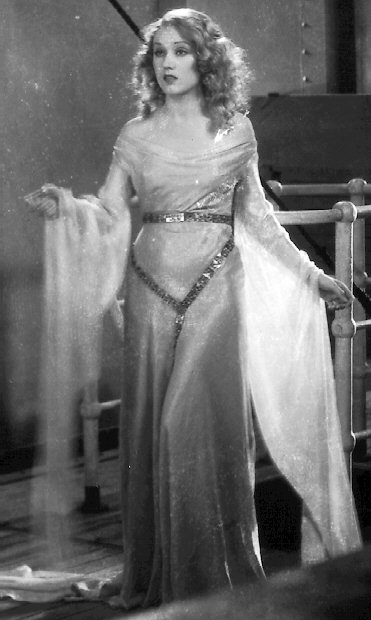
I remember when this classic was first telecast in New York in 1956. They advertised the film for weeks and weeks before it premiered and then it was shown every night for a week on "Million Dollar Movie." But that wasn't unusual. They always had only one film playing for the entire week. And they were all RKO classics, like CITIZEN KANE, THE MAGNIFICENT AMBERSONS, and of course KING KONG. As a young sci-fi and fantasy film freak, I watched KONG every night it was shown and loved every minute of it. It still remains one of my favorite films.
The 1933 KING KONG is in the Top Ten of the 100 Essential Film Scores of the 20th Century

The extra special treat on this original soundtrack is the previously unreleased 24 minute suite from the film, this time without any dialogue.
If you listen to track 14-15 ("The Forgotten Island I and II") and they sound familiar, then give a listen to the opening of THE LOST WORLD: JURASSIC PARK. You'll hear John Williams paying homage to Steiner's great classic score from 1933.
Strangely enough, after listening to this suite, I miss the growls of KONG and the screams of Fay Wray in the film. Unlike more recent films, I'd rather hear this soundtrack with BOTH dialogue and music. And that's what this wonderful release lets you do -- play whatever interests you the most.
The thirty-eight page booklet attached to the CD cardboard cover is a collector's dream - full of marvelous movie stills, concept drawings, movie programs and other publicity. Even the colors of the booklet are muted to suggest the age of this old classic film (and score). Liner notes are superb, written by the very knowledgable Rudy Behlmer. The only slight objection is that the CD is difficult to remove from the cardboard sleeve. My suggestion for collectors: put the CD in a separate blank jewel case.
In his opening remarks in the booklet, film composer Danny Elfman sums it up very nicely when he writes:
"I personally owe Max Steiner and the score to KING KONG a great personal debt. I have often quoted from it and used it for inspiration. Steiner really is the grandaddy, the godfather of this wonderful. maddening crazy art that so many of us are still fans of today."
Take Danny Elfman's advice, even if you have the Label X or Marco Polo CDs, buy this one conducted by the man himself - the Godfather of Film Composers!
Essential to any film music collection.
--Roger Hall, 7 October 1999

"Max Steiner deserves a special paragraph for his musical score...
definitely helps to make KING KONG a big picture."
-- Hollywood Herald, 1933
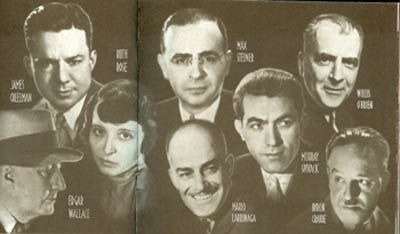
From the original 1933 program at Grauman's Chinese Theater in Hollywood
Shown from the left to right: Edgar Wallace, story; James Creelman and Ruth Rose, screenplay;
Max Steiner, composer; Mario Larrinaga, art technician;
Murray Spivack, sound effects;
Willis O'Brien, chief technician; Bryon Crabbe, art technician.
Max Steiner and the Historic Music for KING KONG
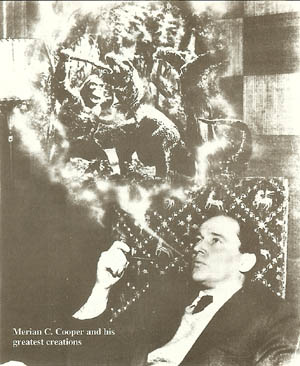
When Merian C. Cooper, under the creative auspices of David O Selznick, assumed the reigns of the financially troubled RKO studios in 1931, he was faced with the daunting task of restructuring production schedules and determining a fresh, new future for the stricken company. Among the proposals and unrealzed projects cluttering his busy desk was an epic prehistoric drama titled CREATION, which would have presented a realistic depiction of behemoth creatures from a time before Man had walked the earth. While Cooper was less than enthralled by the plot of the film, he was intrigued by the possibilities of veteran Stop Motion animator Willis H. O’Brien’s pioneering strides in special effects.
O”Brien had brought THE GHOST OF SLUMBER MOUNTAIN to life in 1919 and, more recently, had created the spectacular visuals for Sir Arthur Conan Doyle’s THE LOST WORLD in 1925. Cooper had long dreamt of realizing his own pet project concerning a giant primordial ape discovered on a lost, uncharted island, fighting dinosaurs, and returning, irrevocably, a vanquished captive to American shores, bound in chains. Inspired by W. Douglas Burden’s book “The Dragon Lizards of Komodo,” Cooper’s original concept involved filming a giganticized gorilla, thrown together with real Komodo lizards, captured and theatrically displayed in Yankee Stadium in New York. Watching O’Brien’s test reel for CREATION in the RKO screening room gave Cooper the germ of an idea, for here was a way to present his martyred ape more realistically than he could ever have imagined, by the utilization of miniatures on a table top set within studio confines.
Cooper shot a test reel to show to the executives in New York, incorporating the log sequence in which the martyred sailors are hurled by Kong into the treacherous ravine below. Presumably, the fabled Spider Crab scene was initially part of the test reel, which ultimately excited corporate loyalists into releasing their cautious purse strings, green lighting production of what would ultimately become KING KONG. Among the earliest casualties of the picture, however, was the ghastly, explicit depiction of the crew being voraciously devoured by Willis O’Brien’s ferocious spider crabs which Cooper, inexplicably, felt slowed the pacing of the picture. Despite erroneous reports over the years that the picture was exhibited in the Phillipines or elsewhere with the historic Spider Crab sequence intact, the sad truth was that Cooper had deleted the entire scene before the picture had even been scored or assigned a composer, and never saw the light of projection outside of the board room in New York or the imposing studio walls.
The initial cut of KING KONG was completed, according to Merian C. Cooper’s unpublished, never finished autobiography, at a final production cost of $513,242.02, leaving the picture without any remaining budget to cover the cost of an original music score. Cooper was, however, adamant in his refusal to settle for the use of stock library tracks to illustrate his theatrical vision. Determined to commission a completely original score for the soundtrack, Cooper offered to pay staff composer, and studio Music Department head, Max Steiner, out of his own pocket in order to create a distinctly original sound for the picture which, according to David Raksin, was estimated at an individual budgetary expense of $50,000.00.
Maximilian Raoul Walter Steiner arrived in Hollywood in 1929, writing the music for some three hundred and ten documented motion pictures beginning with RIO RITA, composed during the year of his arrival, and ending with TWO ON A GUILLOTINE in 1965. Known affectionately by his colleagues as the “Dean of Film Music,” and remembered as “my beloved Maxie” by Merian C. Cooper, Steiner was arguably the most prolific screen composer in film history.
Steiner became the “father” of film music, whose astonishing work effectively sired the fabled golden age of motion picture scoring. His brilliant work on KING KONG became, perhaps, the first important symphonic film score of the sound era.
The composer set about creating a vast, dramatically majestic, powerful plain of emotionally charged depth and complexity. From the moment the film begins, heralding the universally recognized, ominous three bars proclaiming the awesome coming of the great ape, the wary listener is enveloped in a raging onslaught of sound and fury. The slow, calculated ascension of tension, building subliminally to the first hint of arrival on Skull Island, is masterfully interwoven by Steiner’s subtle integration of the deceptive crash of breakers near the shore, with the warning drums of unseen natives from somewhere on the beach. As Carl Denham (Robert Armstrong) and his crew cautiously abandon the protective shelter of the Venture, entering the sinister, seemingly barren village, subversive chanting from somewhere near the great wall, towering before their lonely expedition, consumes the men with unexpected, unrelenting dread. Evolving ever nearer, the provocative sounds gain momentum and strength until, at last, the pale intruders stumble upon a dazzling spectacle; the impending ritualistic sacrifice of a young maiden to a beast the natives call "Kong, Kong.”
The fleeting security of the wary travelers is abruptly shattered when the tribal chieftain observes them hiding in the brush, demanding a halt to the ceremony. Steiner accents every threatening step of the native’s descent from the altar as he advances menacingly toward the frightened intruders. His slow, deliberate steps are contrasted dramatically to the wild, frenetic advance of the threatening witch doctor, potently exacerbated by Steiner’s exilharating score. Yet, this is merely a prelude to the unrestrained ferocity and frenzy of tribal abandon as the kidnapped Ann Darrow (Fay Wray) is offered, in sacrificial rapture, to a raging beast called Kong, holding the island and its populace in “a grip of deadly fear.” It is here that Steiner so unforgettably captures the raw fury, and vengeful fanaticism of the terrified natives in a rite of intoxicated, orgasmic rage. Consumed by the depravity of mortal terror, Steiner’s symphonic nightmare throbs and convulses to a fever pitch, communicating unparalled excitement and intensity, concluding spectacularly at the virtual summit of its emotional aspiration, leaving the helpless listener literally gasping for breath.
In a staggeringly inspired career enduring thirty six years, Max Steiner created the unforgettable accompaniment to such revered motion pictures as CASABLANCA; THE BIG SLEEP; THE TREASURE OF THE SIERRA MADRE; NOW, VOYAGER; THE MOST DANGEROUS GAME; DR. ERLICH'S MAGIC BULLET; THE ADVENTURES OF MARK TWAIN; TOMORROW IS FOREVER; and GONE WITH THE WIND…and yet, his masterpiece remains an historic landmark created in 1933 for Merian C. Cooper, Ernest B. Schoedsack, and troubled RKO Pictures.
A singular fantasy, adventure classic called KING KONG remains among the most poetic, magically inspired, popular, and influential films in over one hundred years of experiential cinema history, and it is with both reverence and awe that we commemorate, and celebrate seventy five years of its uniquely haunting and remarkable music and imagery.
--Steve Vertlieb, 2008
DVD and Books

DVD: KING KONG (Special Edition - 2 Disc Set)
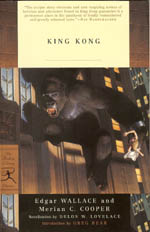
KING KONG (1932 novelization by Delos W. Lovelace)
"The extraordinary Max Steiner score has been studied and emulated many times for its innocvation and cinematic pacing. The music is completely original, unlike other scores for sound pictures of the time." -- Greg Bear, Introduction to this novel
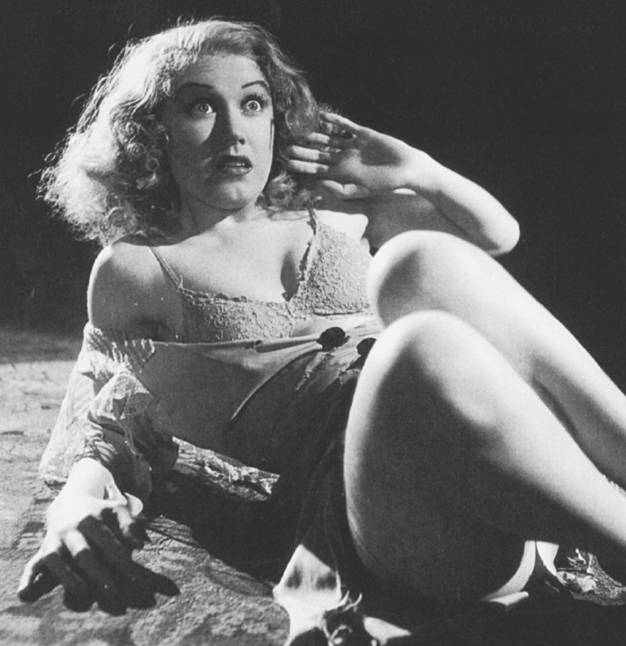
The pictures on this page
are courtesy
of
Delta Entertainment, Marco Polo & Naxos,
Rhino Movie Music, and a private collection
100 Essential Film Scores

KING KONG is listed in the Top 10 of
100 Essential Film Scores of the 20th Century
Help support Film Music Review
.jpg)
Order your copy of this popular book
click here

See the new location of
Film Music Review
